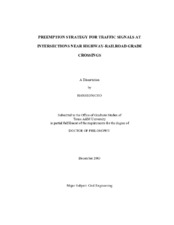| dc.contributor.advisor | Rilett, Laurence R. | |
| dc.creator | Cho, Hanseon | |
| dc.date.accessioned | 2004-09-30T01:57:54Z | |
| dc.date.available | 2004-09-30T01:57:54Z | |
| dc.date.created | 2003-12 | |
| dc.date.issued | 2004-09-30 | |
| dc.identifier.uri | https://hdl.handle.net/1969.1/406 | |
| dc.description.abstract | Because the operational characteristics of signalized intersections near highway-railroad grade crossings (IHRGCs) are different from those of signalized intersections located elsewhere in the traffic system, standard operational strategies do not apply. This is because safe operation at IHRGCs takes precedence over all other objectives.
Because the prime objective of the current preemption methods is to clear the crossing, secondary objectives such as safe pedestrian crossing time and minimized delay are given less consideration or ignored completely. Consequently, state-of-the-practice strategies may cause serious pedestrian safety and efficiency problems at IHRGCs. Therefore, there is a definite need for research on how to improve traffic signal preemption strategies.
An important element of preemption strategy is detection of trains and prediction of arrival times. However, because of the limitations of current detection technologies, estimation algorithms, etc., there is a wide range in these warning times. In this dissertation, a new train-arrival prediction algorithm was developed using detection equipment located farther upstream from the HRGC.
The state-of-the-art transition preemption strategy (TPS) was developed to ensure that as preemption is initiated by approaching trains, the signal display does not change in a manner that endangers either pedestrians or drivers. However, because it does not account for the variability of predicted train arrival times, there is still a possibility of failure.
Therefore, a new transition preemption algorithm that is specifically designed to improve intersection performance while maintaining or improving the current level of safety is developed. This dissertation developed a preemption strategy (TPS3) that uses better train arrival time estimates to improve the safety and efficiency of IHRGCs. The approach was simulated on a test bed in College Station, Texas, and it was concluded that the new TPS improves the safety and operation of intersections near highway-railroad grade crossings. | en |
| dc.format.extent | 1804678 bytes | en |
| dc.format.extent | 459372 bytes | en |
| dc.format.medium | electronic | en |
| dc.format.mimetype | application/pdf | |
| dc.format.mimetype | text/plain | |
| dc.language.iso | en_US | |
| dc.publisher | Texas A&M University | |
| dc.subject | Preemption | en |
| dc.subject | Preemption Warning Time | en |
| dc.subject | Advance Preemption Warning Time | en |
| dc.subject | Minimum Warning Time | en |
| dc.subject | Right-of-Way Transfer Time | en |
| dc.subject | Track Clearance Time | en |
| dc.subject | Preempt Trap | en |
| dc.subject | Transition Preemption Strategy | en |
| dc.title | Preemption strategy for traffic signals at intersections near highway-railroad grade crossings | en |
| dc.type | Book | en |
| dc.type | Thesis | en |
| thesis.degree.department | Civil Engineering | en |
| thesis.degree.discipline | Civil Engineering | en |
| thesis.degree.grantor | Texas A&M University | en |
| thesis.degree.name | Doctor of Philosophy | en |
| thesis.degree.level | Doctoral | en |
| dc.contributor.committeeMember | Woods, Don | |
| dc.contributor.committeeMember | Balke, Kevin | |
| dc.contributor.committeeMember | Urbanik, Thomas, II | |
| dc.contributor.committeeMember | Spiegelman, Clifford | |
| dc.type.genre | Electronic Dissertation | en |
| dc.type.material | text | en |
| dc.format.digitalOrigin | born digital | en |


